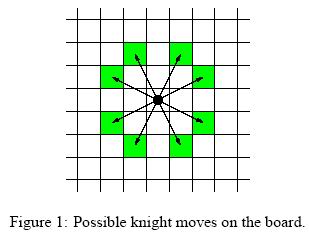HDU1372&&POJ1915
来源:互联网 发布:淘宝指数"怎样应用 编辑:程序博客网 时间:2024/06/04 17:52
Knight Moves
Time Limit: 2000/1000 MS (Java/Others) Memory Limit: 65536/32768 K (Java/Others)Total Submission(s): 5380 Accepted Submission(s): 3287
Problem Description
A friend of you is doing research on the Traveling Knight Problem (TKP) where you are to find the shortest closed tour of knight moves that visits each square of a given set of n squares on a chessboard exactly once. He thinks that the most difficult part of the problem is determining the smallest number of knight moves between two given squares and that, once you have accomplished this, finding the tour would be easy.
Of course you know that it is vice versa. So you offer him to write a program that solves the "difficult" part.
Your job is to write a program that takes two squares a and b as input and then determines the number of knight moves on a shortest route from a to b.
Of course you know that it is vice versa. So you offer him to write a program that solves the "difficult" part.
Your job is to write a program that takes two squares a and b as input and then determines the number of knight moves on a shortest route from a to b.
Input
The input file will contain one or more test cases. Each test case consists of one line containing two squares separated by one space. A square is a string consisting of a letter (a-h) representing the column and a digit (1-8) representing the row on the chessboard.
Output
For each test case, print one line saying "To get from xx to yy takes n knight moves.".
Sample Input
e2 e4a1 b2b2 c3a1 h8a1 h7h8 a1b1 c3f6 f6
Sample Output
To get from e2 to e4 takes 2 knight moves.To get from a1 to b2 takes 4 knight moves.To get from b2 to c3 takes 2 knight moves.To get from a1 to h8 takes 6 knight moves.To get from a1 to h7 takes 5 knight moves.To get from h8 to a1 takes 6 knight moves.To get from b1 to c3 takes 1 knight moves.To get from f6 to f6 takes 0 knight moves.Knight MovesTime Limit: 1000MS Memory Limit: 30000KTotal Submissions: 20208 Accepted: 9365Description
BackgroundMr Somurolov, fabulous chess-gamer indeed, asserts that no one else but him can move knights from one position to another so fast. Can you beat him?The ProblemYour task is to write a program to calculate the minimum number of moves needed for a knight to reach one point from another, so that you have the chance to be faster than Somurolov.For people not familiar with chess, the possible knight moves are shown in Figure 1.Input
The input begins with the number n of scenarios on a single line by itself.Next follow n scenarios. Each scenario consists of three lines containing integer numbers. The first line specifies the length l of a side of the chess board (4 <= l <= 300). The entire board has size l * l. The second and third line contain pair of integers {0, ..., l-1}*{0, ..., l-1} specifying the starting and ending position of the knight on the board. The integers are separated by a single blank. You can assume that the positions are valid positions on the chess board of that scenario.Output
For each scenario of the input you have to calculate the minimal amount of knight moves which are necessary to move from the starting point to the ending point. If starting point and ending point are equal,distance is zero. The distance must be written on a single line.Sample Input
380 07 01000 030 50101 11 1Sample Output
5280两题基本一模一样 BFS求起点到终点的最短距离,可以转化为中国象棋的马走日的形式,第二题POJ上也就是给的那个棋盘变大了而已,其他都是一样的- -。所以一遍BFS搜
过去就可以得到答案。。。#include<cstdio>#include<cstring>#include<cmath>#include<iostream>#include<queue>#include<algorithm>using namespace std;int dis[10][2]={{-2,1},{-2,-1},{2,1},{2,-1},{-1,2},{-1,-2},{1,2},{1,-2}};struct node{int x;int y;int step;}a;int ans;int vis[10][10];void bfs(int x,int y){ if(x==a.x&&y==a.y) { ans=0; return ; } int i; memset(vis,0,sizeof(vis)); vis[x][y]=1; queue<node> q; node aa,bb; aa.x=x; aa.y=y; aa.step=0; q.push(aa); while(!q.empty()) { bb=q.front(); q.pop(); for(i=0;i<8;i++) { aa.x=bb.x+dis[i][0]; aa.y=bb.y+dis[i][1]; aa.step=bb.step+1; if(aa.x==a.x&&aa.y==a.y) { ans=aa.step; return ; } if(aa.x>=1&&aa.x<=8&&aa.y>=1&&aa.y<=8&&vis[aa.x][aa.y]==0) { vis[aa.x][aa.y]=1; q.push(aa); } } }}int main(){ char s1[10]; char s2[10]; node s; while(cin>>s1>>s2) { s.x=s1[0]-'a'+1; s.y=s1[1]-'0'; a.x=s2[0]-'a'+1; a.y=s2[1]-'0'; ans=0; bfs(s.x,s.y); cout<<"To get from "<<s1<<" to "<<s2<<" takes "<<ans<<" knight moves."<<endl; } return 0;}
/**********************************************************************************************************************************/#include<cstdio>#include<cstring>#include<cmath>#include<iostream>#include<algorithm>#include<queue>using namespace std;struct node{int x;int y;int step;}a;int dis[10][2]={{-2,1},{-2,-1},{2,1},{2,-1},{-1,2},{-1,-2},{1,2},{1,-2}};int vis[400][400];int ans;int n;void bfs(int x,int y){ if(x==a.x&&y==a.y) { ans=0; return ; } int i; memset(vis,0,sizeof(vis)); vis[x][y]=1; queue<node> q; node aa,bb; aa.x=x; aa.y=y; aa.step=0; q.push(aa); while(!q.empty()) { bb=q.front(); q.pop(); for(i=0;i<8;i++) { aa.x=bb.x+dis[i][0]; aa.y=bb.y+dis[i][1]; aa.step=bb.step+1; if(aa.x==a.x&&aa.y==a.y) { ans=aa.step; return ; } if(aa.x>=0&&aa.x<n&&aa.y>=0&&aa.y<n&&vis[aa.x][aa.y]==0) { vis[aa.x][aa.y]=1; q.push(aa); } } }}int main(){ int t; cin>>t; node s; int sx,sy; int ex,ey; while(t--) { cin>>n; cin>>sx>>sy; cin>>ex>>ey; s.x=sx; s.y=sy; a.x=ex; a.y=ey; ans=0; bfs(s.x,s.y); cout<<ans<<endl; } return 0;}
0 0
- HDU1372&&POJ1915
- POJ1915
- poj1915
- poj1915
- poj1915
- POj1915
- POJ1915
- poj1915
- hdu1372
- hdu1372
- hdu1372
- HDU1372
- HDU1372
- HDU1372
- poj1915 BFS
- poj1915 bfs
- POJ1915 BFS
- HDU1372 BFS
- 宽带连接:813错误(813error)解决方案
- CSerialPort串口类的修正版2014-01-10
- 鼠标覆盖行高亮显示 奇偶行背景颜色不同 css+jquery Table
- 东北大学计算机专业研究生入学考试2007年真题原题
- Linux下用nethogs查看每个进程占用带宽的情况
- HDU1372&&POJ1915
- js倒计时代码
- 嵌入式系统开发学习步骤(Linux高级编程学习顺序)
- 前端设计中的渐进增强与优雅降级
- Apache Flume初识
- UIBezierPath 的使用介绍
- 26、高级工具--在设置中心中启用程序锁服务
- UVa:11481 Arrange the Numbers
- uva 639 Don't Get Rooked



